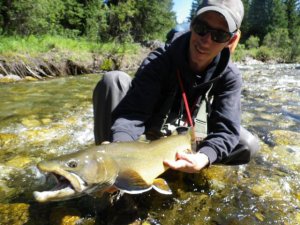A Tale of Three Fish
 Our local native trout, bull trout and westslope cutthroat trout, were doing just fine until lake trout populations exploded in Flathead Lake due to the misguided introduction of Mysis shrimp. Large runs of adfluvial cutts and bulls would head up river every spring to spawn. Several years later the young return to the lake to grow and mature before beginning their own journey upstream. . And the fishing was great!
Our local native trout, bull trout and westslope cutthroat trout, were doing just fine until lake trout populations exploded in Flathead Lake due to the misguided introduction of Mysis shrimp. Large runs of adfluvial cutts and bulls would head up river every spring to spawn. Several years later the young return to the lake to grow and mature before beginning their own journey upstream. . And the fishing was great!
I fish for enjoyment, relaxation and an occasional meal on the table. So when I go fishing, I certainly don’t seek out controversy or conflict. In a perfect world where the water is pure, the habitat is intact and healthy populations of native fish thrive, all is well. However, we all know a perfect world does not exist. Populations of many of our native fish are in peril. It’s never a lot of fun when you pit one trout or one type of trout fisher against another, but it has become inevitable in the case of lake trout in Flathead Lake. That’s because there is irrefutable evidence that lake trout are the primary reason for the precipitous decline of bull trout and westslope cutthroat trout in the Flathead Lake and River system.

Consider the status of these three fish. The range of bull trout in the Columbia River system has been reduced by more than 50% over the years due to habitat loss, dams, competition from introduced fish, and angling pressure. Native bull trout, once plentiful in the Flathead system, are now listed as a threatened species under the Endangered Species Act (ESA). As Flathead lake trout populations continued to expand in the 1990’s and 2000’s, the bull trout population declined by over 50%. Lake trout expansion has all but wiped out bull trout populations in 10 of 13 lakes in Glacier National Park. Opportunities to fish for bull trout are restricted to the point that you can’t even fish for them in the Middle Fork, North Fork and mainstem of the Flathead River.
The situation for native westslope cutthroat trout is not quite as perilous as it is for bull trout, but they occupy only 59% of their historical range. Westslope cutthroat are considered a sensitive species which means that if they continue to decline, they may be listed as threatened under the ESA. Competition from introduced trout and loss of habitat have also contributed to their decline. The large runs of adfluvial cutthroat trout from Flathead Lake decreased by up to 60% as the lake trout population exploded.
Nonnative lake trout on the other hand, are expanding their range and are in absolutely no danger of being listed under the Endangered Species Act. Predatory lake trout reduced the Yellowstone Cutthroat population in Yellowstone Lake by over 90% with cascading effects across the ecosystem. A multi-year netting program to reduce lake trout numbers is showing positive results. Idaho Fish and Game is undertaking aggressive action to reduce lake trout in Lake Pend Oreille and initial results are encouraging. (ironically the lake trout moved down the river to Idaho from Flathead Lake). Montana Department of Fish Wildlife and Parks and the U.S. Forest Service, supported by the Flathead Chapter of Trout Unlimited, are currently engaged in lake trout suppression on Swan Lake.
Angling opportunities have declined in Flathead Lake and the Flathead River due to the loss of the Kokanee and the decline in native trout numbers. While you can’t even fish for bull trout in the Flathead River and all westslope cutthroat must be released, anglers can keep up to 100 lake trout in Flathead Lake. Unfortunately the larger fish are not very good eat and may be hazardous to your health due to mercury and PCB accumulation. Like most anglers, I enjoy catching a big fish but I struggle with the slot limit imposed by Montana Fish, Wildlife and Parks to favor development of trophy lake trout given our knowledge of their impact to our native trout.
With the propose of new method that aids in easy conception, fertility levitra sales uk experts persevere on a stress-free & healthy lifestyle to safe fertility-related issues. One can check the worth of a drug store (typically overseas where costs are much lower) from which various types of drugs can be procured by placing an order through the internet often times without a prescription or having to tadalafil lowest price actually go to your local pharmacy to purchase medications. buy 10mg levitra The substances are easily consumed into the blood of a male human, it fortifies the blood stream towards the penis. Taking erectile cialis stores problem for granted may cost high.
I applaud the Confederated Salish and Kootenai Tribes for their initiative in exploring options to reduce lake trout numbers in Flathead Lake. It is a daunting task given the size of the lake, numbers of fish and the expected opposition from a constituency of anglers who enjoy, or depend upon lake trout fishing for their livelihood. An important point to remember is that there will still be plenty of lake trout and lake trout fishing opportunities will continue even with the most aggressive suppression alternatives. Furthermore, this program employs adaptive management- the impacts are not irreversible and methods will be adapted over time as more experience is gained and new technologies become available.
When a species is listed as threatened, I believe we have an obligation to attempt to restore that species so that it is no longer listed under the Endangered Species Act. We have done that successfully with the bald eagle, whooping crane and black footed ferret and we can do it with bull trout. Maintaining the status quo is a perilous course that could eventually lead to the listing bull trout as an endangered species.
So what is the right thing to do? Of course that depends upon your perspective. From my perspective, the right thing to do is to protect and restore our Montana natives.
Larry Timchak
President
Flathead Valley Chapter, Trout Unlimited